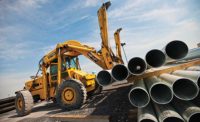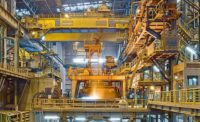Just how bad has the recent oil-and-gas downturn been as it relates to the PVF market?
“This is markedly one of the worst oil-and-gas cycle downturns in history with global exploration and production spending down more than 45% in the last two years,” MRC Global President and CEO Andrew Lane says. “We haven’t experienced a two-year sequential decline of this magnitude since the mid-1980s. While there are many predictions on when a recovery could take place, commodity oil-and-gas prices remain very volatile.”
Lane rattles off two numbers to back up his point. He notes the WTI oil price rocketed to $140 a barrel in 2008 and then nosedived to as low as $28 a barrel earlier this year. “Our customers, other PVF distributors, oilfield service companies, drilling-rig contractors and all equipment suppliers and service companies either directly or indirectly tied to the oil-and-gas end market have had to adjust to the current industry outlook,” he says.
Lane was one of a number of industry executives on the distribution end of the channel who offered their thoughts and opinions to Supply House Times on the current state of the industrial PVF industry and what the future could bring.
Dennis Fikes, president of Houston-based industrial PVF master distributor Energy Metals, says the current downturn traces well beyond the United States. “Demand is down, not just in the U.S., but all over the world,” he says. “Normally there is at least one part of the world experiencing rapid growth. That is not happening now. Asia is slow, the Middle East is slow and Europe is slow. There is not a bright spot at the moment. What is driving this? Oil prices, almost all economies are not in good shape, many countries are in civil unrest and I think too many people have dropped out of the workforce. When people are working, they are spending. When they are buying product demand goes up.”
Looking for answers
Some insiders who participated in this story believe one key factor in a market turnaround will be the result of the upcoming presidential election. “In the short term, the election is a concern,” says Todd Ford, CEO and president of Omaha, Neb.-based distributor Central States Group. “Anytime there is uncertainty in our political landscape and potential policy changes, the direct financial impact can be difficult to plan around.”
Rob Raban, president of Rancho Dominguez, Calif.-based industrial PVF master distributor Industrial Valco, adds: “I’m hopeful we are at the tail end of the current downturn, but I think the November elections will help answer this question. A government with an appetite for domestic industry and manufacturing will help get things back on track.”
Scott Jensky, northern Wisconsin regional manager for Chicago-based distributor Columbia Pipe and Supply, says election uncertainty is nothing new in the PVF industry. “Historically election years are down with money being held back until the next administration is known,” he says.
Chicago Tube & Iron Director of Marketing-PVF Rob Powers lists politics as one of several contributing factors to the current state of the market. “The industrial PVF industry could be much stronger,” he says. “2016 has been largely the same as 2015 with companies sitting on a lot of cash rather than spending capital because of low oil prices, political turmoil and security threats.”
On a regional level, F.W. Webb Senior Vice President of Industrial Business Development Ernie Coutermarsh labels the PVF market in the company’s Northeast base as flat, also due to myriad factors. “I expect it to remain this way for the foreseeable future,” he says. “Paper mills are closing, manufacturers are moving investment to more business-friendly states in the south and west, companies are getting acquired and consolidating resources, and fossil-fuel and nuclear power plants are closing.”
Not all gloom and doom
While the downturn in recent times has been significant, industry executives do see light at the end of the tunnel in terms of improving market conditions.
“We see the industrial valve industry pretty flat for the remainder of 2016, but looking into 2017 we feel there may be some turnaround in the latter part of the year,” says Bill Sandler, president of the Valve Manufacturers of America. “As far as 2017, although the oil-and-gas market will not see growth, this will be more than offset by strong growth in industries such as water and wastewater, construction, chemical, mining, and iron and steel. We also see growth internationally, which will reflect in our 2017 exports.”
Alan Lipp, COO of Cleveland-based master distributor Merit Brass, notes demand was disappointing in the first half due to inventories throughout the channel being continuously cut amid a backdrop of low prices for all metals (he notes nickel hit a 13-year low).
“Since nickel is the most thinly traded base metal, prices can be very volatile and relatively modest changes in demand or supply can trigger big price differences,” he explains. “While LME nickel stocks remain very high, there are concerns the new Philippines regime may reduce the supply of nickel ore due to environmental concerns. That has been the catalyst in spot prices jumping 25% compared to the end of May. Due to the Indonesian ban on ore already in effect, a significant curtailment of Philippine supply would almost certainly cause continued inflation of nickel prices.”
But recently Lipp has seen some positive movement on the metals front. “Metal prices started increasing in July and if higher prices are sustained, we should see some consequential restocking,” he says. “We’d expect that to feed on itself — similar to how the destocking fed itself — and lead to higher raw material prices, especially nickel.”
Gary Stratiner, president and CEO of Kent, Wash.-based Puget Sound Pipe & Supply, is no stranger to market downturns. His advice is simple: be patient and business savvy. “This isn’t anything us old-timers haven’t seen before,” he says. “We’ve had the same downturn four times since I started working in 1973. What we have to remember and teach the next generation is it is temporary. Hopefully, you learn from your mistakes. What you have to do is manage your costs and inventory. What gets distributors in trouble is high-priced inventory when raw material costs go down. The products we sell are made of steel and copper, not gold. One of my favorite sayings when steel prices get out of control on the high side is, ‘It’s only pig iron.’ You have to be disciplined and realize they eventually will come back to reality.”
MRC Global’s Lane says an industry turnaround isn’t a matter of if, but when. “Our primary energy end market always has been cyclical,” he says. “There’s no doubt we are in the midst of one of the most challenging two-year cycles in oil-and-gas history, but the market will turn as the global demand for energy continues to increase. The question is only when that recovery will happen.”
This article was originally titled “What will the future bring?” in the August 2016 print edition of Supply House Times.





